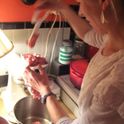Bread Advice
I used to make bread here and there with some pretty good success. Granted, this was in San Francisco and it was never with a starter. I was determined, though, after reading an article in Saveur recently to try a starter once and for all. So I tended it and cared for it for 10 days and today I finally got to make it. While it tastes great, it did not rise as much as I thought it should and was rather dense (here my dad would say, Love to! do you tango?). I am assuming this could have to do with me being in the mile high city, but I am a "cooker" not a "baker" and have exhibited little patience in troubleshooting. Any ideas would be appreciated. Can I keep the starter and adjust the recipe? This is what I used: http://www.saveur.com/article....
18 Comments
I made a tutorial recently to make homemade bread (you can eat it with sweet food as well as any kind of meal), and if you follow my advices your bread should rise:
https://www.youtube.com...
I hope it can help you! :)
I thought the hot Philadelphia July weather would be great for beginning my starter, but I came to realize that the cooler nights were slowing things down too much. So before going to bed I would turn on my oven to the lowest temp, then turn it off and open door; when I could comfortably hold my finger to the wall of the oven I would put my starter in and shut the door until the morning. I do the same thing when I am letting the dough rise. In other words, even though my book says keep starter around 75-85 degrees I am keeping it at the 85 or more end of the spectrum.
I have made several nice-looking batards using my stiff levain and have been stashing bits of it in the freezer in case I don't keep up with the weekly levain feeding schedule. Maybe I can thaw those without having to completely start over. I was really amused when, while researching online, I found recommendations like 'the best way to make a sourdough starter is to use a bit of starter from someone else.' (You don't say?)






